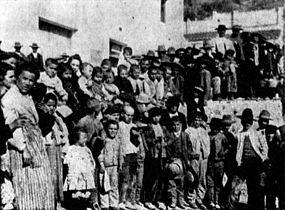Title: The Spanish Migration to the USA: A Rich Tapestry of Culture and Influence
The migration of Spanish people to the United States has been a diverse and multifaceted phenomenon that has left a significant imprint on American history, culture, and society. From the early explorers and settlers to the modern-day immigrants, Spanish migration has shaped the American landscape in myriad ways.

Early Spanish Exploration and Settlement
The Spanish presence in what is now the United States dates back to the 16th century, with the arrival of explorers such as Juan Ponce de León, Hernando de Soto, and Francisco Vázquez de Coronado. Spanish expeditions established settlements, such as St. Augustine in Florida (founded in 1565) and Santa Fe in New Mexico (founded in 1610), laying the foundation for Spanish influence in North America.
Influence on Language, Place Names, and Culture
Spanish migration has left a lasting impact on American language, with Spanish words and phrases woven into everyday vocabulary. Place names across the United States, from California to Florida, reflect the Spanish heritage of these regions. Additionally, Spanish culture, including food, music, and traditions, has become an integral part of the American cultural tapestry.
Colonial Legacy in the Southwest
In the 18th and 19th centuries, Spanish settlers expanded into present-day Texas, New Mexico, Arizona, and California, establishing ranches, missions, and trading posts. The legacy of Spanish colonization is evident in the architecture of adobe buildings, the influence of Catholicism, and the enduring cultural traditions of Hispanic communities in the Southwest.
Mexican-American War and Annexation of the Southwest
Following the Mexican-American War (1846-1848), the United States acquired vast territories in the Southwest, including present-day California, Arizona, New Mexico, and parts of Texas, Colorado, Nevada, and Utah. The influx of Spanish-speaking Mexicans into the United States, coupled with the existing Hispanic population, further enriched American society and culture.
20th Century Immigration and Cultural Exchange
In the 20th century, waves of Spanish immigrants arrived in the United States, seeking economic opportunity and fleeing political instability in their home countries. Spanish-speaking communities grew in cities like Los Angeles, Miami, New York, and Chicago, contributing to the cultural vibrancy and diversity of urban America.
Contributions to Arts, Cuisine, and Music
Spanish immigrants and their descendants have made significant contributions to American arts, cuisine, and music. Spanish cuisine, with its emphasis on flavors like chili peppers, tomatoes, and cilantro, has become popular across the United States. Spanish and Latin American music genres, such as salsa, merengue, and flamenco, have also influenced American musical traditions.
Challenges and Achievements
Despite facing challenges such as discrimination and economic hardship, Spanish immigrants have made remarkable achievements in various fields, including business, politics, sports, and the arts. Spanish-Americans have played vital roles in shaping American culture and society, from labor leaders like Cesar Chavez to entertainers like Rita Moreno and athletes like Roberto Clemente.
Conclusion
The Spanish migration to the United States has been a dynamic and enriching process, contributing to the diversity, vitality, and cultural richness of the nation. From the early explorers and settlers to the modern-day immigrants, Spanish-Americans have left an indelible mark on American history and identity. Their legacy serves as a testament to the enduring bonds of culture, heritage, and shared humanity that unite the peoples of the Americas.
